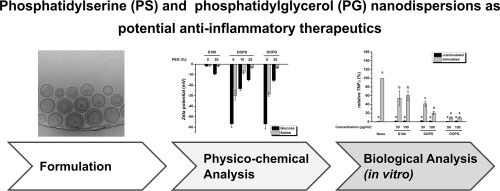Nanomedicine: Nanotechnology, Biology and Medicine ( IF 4.2 ) Pub Date : 2019-10-25 , DOI: 10.1016/j.nano.2019.102096 Miriam Elisabeth Klein , Simone Mauch , Max Rieckmann , Dailén Garcí Martínez , Gerd Hause , Michel Noutsias , Ulrich Hofmann , Henrike Lucas , Annette Meister , Gustavo Ramos , Harald Loppnow , Karsten Mäder

|
Phosphatidylserine (PS) and phosphatidylglycerol (PG) are endogenous phospholipids with putative anti-inflammatory potential. However, studies comparing PS and PG are rare and were mainly conducted with phospholipid-dispersions of large size and broad distributions. Thus, we prepared small-sized PS- and PG-loaded liposomes exhibiting narrow distribution, and additionally studied the impact of liposome-pegylation on the reduction of the TNFα-production caused by the PS- and PG-liposomes. These PS- and PG-containing nanodispersions had a small size around 100 nm and a narrow distribution (PDI < 0.1). The liposome-dispersions showed no toxicity in NHDF- and 3T3-cells and virtually no hemolytic activity. They decreased the TNFα-production of LPS-(lipopolysaccharide)-stimulated mouse peritoneal macrophages in vitro. PG-liposomes always decreased the TNFα-levels more potently than PS-liposomes. Pegylation of PS- and PG-liposomes caused different Zeta potentials, but did not change biological activity. The results of the current study indicate a high potential of the tested formulations for phospholipid-based anti-inflammatory therapies.
中文翻译:

磷脂酰丝氨酸(PS)和磷脂酰甘油(PG)纳米分散体作为潜在的抗炎药:体外活性和聚乙二醇化的影响比较
磷脂酰丝氨酸(PS)和磷脂酰甘油(PG)是具有推定的抗炎潜力的内源性磷脂。然而,比较PS和PG的研究很少,主要是通过大尺寸和宽分布的磷脂分散液进行的。因此,我们制备了显示狭窄分布的小尺寸PS和PG脂质体,并另外研究了聚乙二醇化脂质体对PS和PG脂质体引起的TNFα产生减少的影响。这些含PS和PG的纳米分散体在100 nm处尺寸较小,分布较窄(PDI <0.1)。脂质体分散液对NHDF和3T3细胞没有毒性,并且几乎没有溶血活性。它们降低了TNFα生产LPS-(脂多糖)刺激的小鼠腹腔巨噬细胞的体外。PG脂质体总是比PS脂质体更有效地降低TNFα水平。PS-和PG-脂质体的聚乙二醇化引起不同的Zeta电位,但没有改变生物活性。当前研究的结果表明,所测试的制剂在基于磷脂的抗炎治疗中具有很高的潜力。











































 京公网安备 11010802027423号
京公网安备 11010802027423号